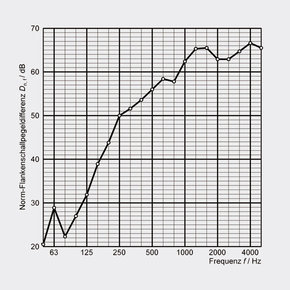Longitudinal soundproofing
A major criterion for the acoustic quality of a building is the sound transmission from room to room and from floor to floor. The better the building materials employed absorb the longitudinal sound, the smaller the disturbing influences.
As so often, the law of the weakest link applies here as well. If a component has a sound insulation factor of e.g. 20 dB, the resulting sound insulation factor of the whole system will never be better than 20 dB, no matter how good the remaining components are. For this reason, not only the degree of absorption but also the longitudinal sound insulation factor must be taken into consideration when selecting the products used.
OUTSTANDING INSULATION VALUES
The latest tests performed in accordance with DIN EN ISO 10848-2 show outstanding results.
Strip-grid and clip-in strip grid systems with the following structure were tested:
- Perforated FURAL metal ceiling
- Mineral wool inlay welded into PE film
- Plasterboard or steel cover
Values achieved:
- Ceiling tile with plasterboard cover: up to 56 dB
- Ceiling tile with steel cover: up to 52 dB
The systems permit quick and flexible adaptation of the rooms for the developer or tenant in the event of changes in use. Thanks to the outstanding insulation properties, components such as plasterboard partitions can be omitted, hence yielding significant savings potential.









